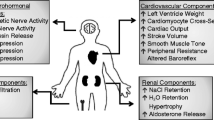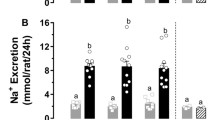Abstract
The spontaneously hypertensive rat (SHR) is an important animal model of human essential hypertension. During the first month of life, increased retention of sodium is present in the SHR which appears to be mediated by the renin-angiotensin system. The present review will discuss the role that increased activity of the renin-angiotensin system plays in sodium/body fluid regulation during early development. It is hypothesized that disordered regulation of sodium/body fluid homeostasis during this stage leads to pathological cardiovascular regulation in adulthood. Through an understanding of the relationship between sodium/body fluid balance in the young and cardiovascular function in the adult insights may be gained into both the pathological state of hypertension and the critical role played by early development in shaping homeostatic mechanisms in adulthood.
Similar content being viewed by others
References
Beierwaltes, W. H., Arendshorst, W. J., and Klemmer, P. J., Electrolyte and water balance in young spontaneously hypertensive rats. Hypertension4 (1982) 908–915.
Black, I. B., Stages of neurotransmitter development in autonomic neurons. Science215 (1982) 1198–1204.
Blizard, D. A., and Adams, N., Maternal influences on cardiovascular pathophysiology. Experientia48 (1992) 334–345.
Brody, M. J., and Zimmerman, B. G., Peripheral circulation in arterial hypertension. Prog. cardiovasc. Dis.18 (1976) 323–340.
Cierpial, M. A., and McCarty, R., Hypertension in SHR rats; contribution of maternal environment. Am. J. Physiol.253 (1987) H980–H984.
Contreras, R. J., and Kosten, T., Prenatal and early postnatal sodium chloride intake modifies the solution preferences of adult rats. J. Nutrit.113 (1983) 1051–1062.
Contreras, R. J., Differences in perinatal NaCl exposure alters blood pressure levels of adult rats. Am. J. Physiol.256 (1989) R70–R77.
DiBona, G. F., The functions of the renal nerves. J. Physiol. Biochem. Pharmac.94 (1982) 76–181.
DiBona, G. F., Neural regulation of renal tubular sodium reabsorption and renin secretion: Integrative aspects. Clin. exp. Hypertens. Theory PracticeA 9 (1987) 151–165.
DNicolantonio, R., Marshall, S. J., Nicolaci, J. A., and Doyle, A. E., Blood pressure and saline preference of cross-suckled genetically hypertensive and normotensive rats: Role of milk electrolytes. J. Hypertens.4 (1986) S253–S254.
Gattone, V. H., Evan, A. P., Overhage, J. M., and Severs, W. B., Developing renal innervation in the spontaneously hypertensive rat: evidence for a role of the sympathetic nervous system in renal damage. J. Hypertens.8 (1990) 423–428.
Gomez, R. A., Lynch, K. R., Chevalier, R. L., Wilfong, N., Everett, A., Carey, R. M., and Peach, M. J., Renin and angiotensinogen gene expression in maturing rat kidney. Am. J. Physiol.254 (1988) F582–F587.
Guyton, A. C., Coleman, T. G., Cowley, A. W. Jr., Manning, R. D., Norman, R. A. Jr., and Ferguson, J. D., A systems analysis approach to understanding long-range arterial blood pressure control and hypertension. Circ. Res.35 (1974) 159–176.
Hall, W. G., Weaning and growth of artificially reared rats. Science190 (1975) 1313–1315.
Harrap, S. B., and Doyle, A. E., Renal haemodynamics and total body sodium in immature spontaneously hypertensive and Wistar-Kyoto rats. J. Hypertens.4 (1986) S249–S252.
Johnson, A. K., Brain mechanisms in the control of body fluid homeostasis, in: Perspectives in Exercise Science and Sports Medicine, vol. 3: Fluid Homeostasis During Exercise. pp. 347–419. Eds C. V. Gisolfi and D. R. Lamb. Benchmark Press, Indianapolis 1990.
Kirby, R. F., and Johnson, A. K., Effects of sympathetic activation on plasma renin activity in the developing rat. J. Pharmac. exp. Ther.253 (1990) 152–157.
Kirby, R. F., and McCarty, R., Ontogeny of functional sympathetic innervation to the heart and adrenal medulla in the preweaning rat. J. auton. Nerv. Syst.19 (1987) 67–75.
Kirby, R. F., Page, W. V., Cutshall, S., Porter, G. C., and Robillard, J. E., Effects of dietary salt manipulation on kidney renin gene expression in artificially reared newborn SHR and WKY rats. Soc. Pediat. Res. Abstracts, 1991.
Langer, S. Z., Presynaptic regulation of the release of catecholamines. Pharmac. Rev.32 (1981) 337–362.
Matsushima, Y., Kawamura, M., Akabane, S., Imanishi, M., Kuramochi, M., Ito, K., and Omae, T., Increases in renal angiotensin II content and tubular angiotensin II receptors in prehypertensive spontaneously hypertensive rats. J. Hypertens.6 (1988) 791–796.
McCarty, R., Cierpial, M. A., Murphy, C. A., Lee, J. H., and Fields-Okotcha, C., Maternal involvement in the development of cardiovascular phenotype. Experientia48 (1992) 315–322.
McCarty, R., Kirby, R. F., Cierpial, M. A., and Jenal, T. J., Accelerated development of cardiac sympathetic responses in spontaneously hypertensive (SHR) rats. Behav. Neural Biol.48 (1987) 321–333.
McCarty, R., Cierpial, M. A., Kirby, R. F., and Jenal, T. J., Development of cardiac sympathetic and adrenal-medullary responses in borderline hypertensive rats. J. auton. Nerv. Syst.21 (1987) 43–49.
McMurty, J. P., Wright, G. L., and Wexler, B. C., Spontaneous hypertension in cross-suckled rats. Science211 (1981) 1173–1175.
Messer, M., Thoman, E. B., Terrasa, A. B., and Dallman, P. R., Artificial feeding of infant rats by continuous gastric infusion. J. Nutrit.98 (1969) 404–410.
Moe, K. E., The salt intake of rat dams influences the salt intake and brain angiotensin receptors of their adult offspring. Neurosci. Abstr. (1987) 1169.
Mouw, D. R., Vander, A. J., and Wagner, J., Effects of prenatal and early postnatal sodium deprivation on subsequent adult thirst and salt preference in rats. Am. J. Physiol.234 (1978) F59–F63.
Myers, M. M., and Scalzo, F. M., Blood pressure and heart rate responses of SHR and WKY rat pups during feeding. Physiol. Behav.44 (1987) 75–83.
Myers, M. M., Shair, H. N., and Hofer, M. A., Feeding in infancy: Short- and long-term effects on cardiovascular function. Experientia48 (1992) 322–333.
Nagoaka, A., Kakihana, M., Fujiwara, K., and Shimakawa, K., Reduced ability to excrete sodium and water in young spontaneously hypertensive rats, in: Hypertensive Mechanisms, pp. 249–251. Eds W. Rascher, D. Clugh and D. Ganten. Schattauer Verlag, Stuttgart-New York 1982.
Salvi, D., Brady, R., Thomas, D., and Lau, K., Evidence for increased renal Na retention by pre-hypertensive spontaneously hypertensive rats (SHR): Role of mineralocorticoids. Clin. Res.33 (1985) 883A.
Sinaiko, A., and Mirkin, B. L., Ontogenesis of the renin-angiotensin system in spontaneously hypertensive and normal Wistar rats. Circ. Res.34 (1974) 693–696.
Slotkin, T. A., Whitmore, W. L., Orband-Miller, L., Queen, K. L., and Haim, K., Beta adrenergic control of macromolecule synthesis in neonatal rat heart, kidney, and lung: relationship to sympathetic neuronal development. J. Pharmac. exp. Ther.243 (1987) 101–109.
Smith, P. G., Poston, C. W., and Mills, E., Ontogeny of neural and non-neural contributions to arterial blood pressure in spontaneously hypertensive rats. Hypertension6 (1984) 54–60.
Sripanidkulchai, B., and Wyss, J. M., The development of alpha-2 adrenoceptors in the rat kidney: Correlation with noradrenergic innervation. Brain Res.400 (1987) 91–100.
Tucker, D. C., Bhatnagar, R. K., and Johnson, A. K., Genetic and environmental influences on developing autonomic control of heart rate. Am. J. Physiol.246 (1984) R578–R586.
Tucker, D. C., and Johnson, A. K., Development of autonomic control of heart rate in genetically hypertensive and normotensive rats. Am. J. Physiol.246 (1984) R570–R577.
Author information
Authors and Affiliations
Rights and permissions
About this article
Cite this article
Kirby, R.F., Johnson, A.K. Regulation of sodium and body fluid homeostasis during development: Implications for the pathogenesis of hypertension. Experientia 48, 345–351 (1992). https://doi.org/10.1007/BF01923428
Issue Date:
DOI: https://doi.org/10.1007/BF01923428




